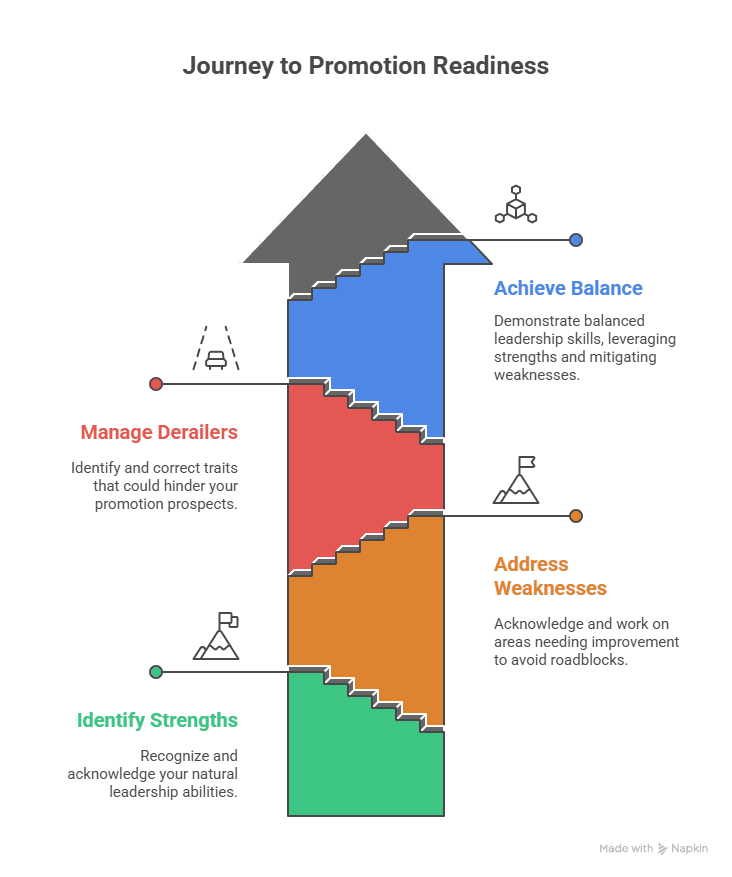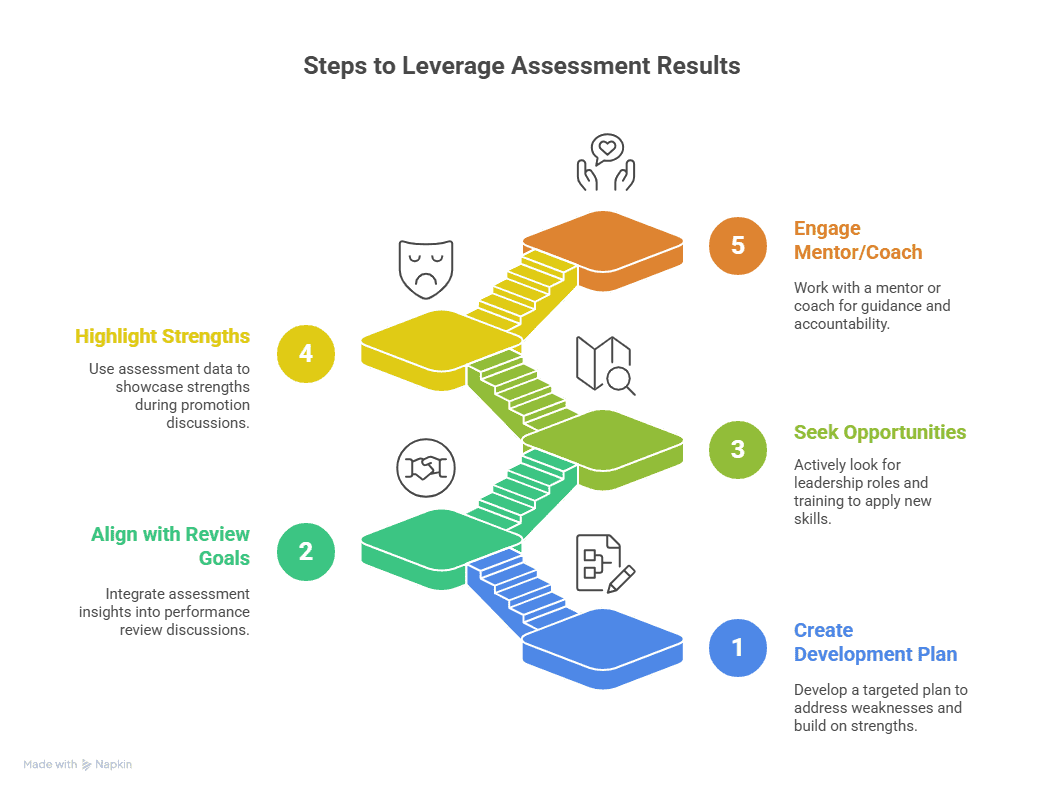How to Use a Leadership Development Assessment to Secure Your Next Promotion

Excelling in your current role is not enough to guarantee a promotion. In today’s competitive job market, you need to demonstrate leadership potential and actively invest in self-improvement. One powerful way to do this is by leveraging a leadership development assessment. Such an assessment can uncover your strengths and weaknesses as a leader, guiding you to close skill gaps and showcase your readiness for advancement. This post will explain what a leadership assessment is, why it’s valuable for career growth, and how to use your results in performance reviews and development plans to secure your next promotion.
What Is a Leadership Development Assessment?
A leadership development assessment (often called a leadership skills assessment) is a systematic evaluation of your leadership abilities, traits, and competencies. It typically involves answering questionnaires or 360-degree feedback surveys to measure things like your communication style, decision-making, emotional intelligence, and management skills. The goal is to identify your strengths and areas needing improvement as a leader. In other words, leadership assessments evaluate your skills, strengths, and weaknesses, providing insights to enhance your effectiveness and personal growth.
There are many types of leadership assessments. For example, personality-based tools (like DiSC or Myers-Briggs) reveal your work style and how you interact with others, while 360° feedback assessments gather input from peers and team members to paint a comprehensive picture of your leadership performance. No matter the format, all assessments help shine a light on your abilities, including behavioral patterns and skill gaps. This increased self-awareness lays the foundation for targeted improvement and continuous growth in your career.
Why Use a Leadership Assessment for Career Advancement?
Using a leadership assessment for career growth can give you a significant edge when aiming for a promotion. Promotions – especially into management or executive roles – require more than just doing your current job well. Organizations look for people with proven leadership potential. In fact, not all top performers are automatically great leaders; an assessment can distinguish day-to-day performance from true leadership potential by evaluating traits like learning agility, drive, and interpersonal effectiveness. By proactively assessing yourself, you demonstrate initiative and identify what it takes to step up to the next level.
One key benefit is self-awareness. Leadership assessments highlight your personal leadership style, strengths, and any weaknesses or “blind spots” you might havepositivepsychology.com. This is crucial for career advancement because you can’t improve what you don’t understand about yourself. Knowing your leadership competencies (and where you fall short) allows you to align your development with the skills needed for higher roles. It also shows your managers that you are serious about growth. Rather than waiting for others to point out areas for improvement, you come prepared with data on yourself and a plan to get better.
Importantly, assessment results provide objective feedback you can use to guide your career development. Instead of vague ideas about “improve communication” or “be more strategic,” you’ll have concrete insights and metrics. For example, a 360-degree assessment might reveal that while you excel in technical expertise, your delegation or team coaching skills are lacking. With this knowledge, you can set specific goals to develop those leadership competencies. Such data-driven development is often viewed favorably by leadership, as it aligns personal growth with organizational leadership criteria. Ultimately, leadership assessments can guide you to where your focus should be, so you spend your energy on the skills that will actually help you get promoted.
Uncovering Strengths and Gaps to Prepare for Promotion
One of the greatest advantages of a leadership skills assessment is uncovering your hidden strengths and pinpointing gaps that might be holding you back. Understanding these facets helps you become promotion-ready. A good assessment will clearly show what you’re already great at – for instance, maybe you have a natural strength in strategic thinking or motivating others. It will also highlight areas that need improvement, which are potential roadblocks to advancement. Many leadership assessments are designed to do exactly this: identify strengths, flag weaknesses, and even suggest what roles or environments you’re best suited for.

By facing your development areas head-on, you can start improving them before they hinder your promotion prospects. For example, imagine your assessment reveals you struggle with delegating tasks. In a higher-level role, an inability to delegate could become a serious liability. Knowing this now gives you the chance to practice trusting your team and sharing responsibilities, so that by the time you’re being considered for a leadership role, you’ve turned that weakness into a strength. In one real-world case, an executive’s assessment showed she was a very “cautious” leader who tended to avoid delegating and took on too much herself. Armed with this insight, she learned to rely on her team more and share responsibilities – a change that made her a far more effective leader. This kind of transformation can be career-defining.
Leadership assessments can also uncover any potential “derailers” in your style – traits that, if left unaddressed, could derail your chances of promotion. Common derailers might include difficulty handling feedback, poor emotional control under stress, or a lack of initiative. These often surface when candidates are evaluated for promotion. It’s far better to discover and correct them early. By using the assessment as a mirror, you can start managing those risk factors now. The result is that when you do step into a higher-responsibility role (or interview for one), there are no nasty surprises. You’ll be able to confidently demonstrate that you have balanced leadership skills – leveraging your strengths and mitigating your weaknesses – making you a strong candidate for promotion.
Leveraging Assessment Results in Performance Reviews and Development Plans

Identifying your leadership strengths and gaps is only step one. The next step is leveraging those results to actively drive your promotion forward. Here are some effective ways to use your assessment results in your performance reviews and personal development plan:
- Create a targeted development plan:
Don’t just file away your assessment report – turn it into an action plan. Outline specific steps to improve on the weaknesses and build on the strengths identified. For example, if the assessment shows you need better conflict resolution skills, you might plan to take a workshop on difficult conversations or practice conflict scenarios with a mentor. It makes little sense to assess someone’s leadership traits and then do nothing with the information. Instead, develop arobust personal development plan that might include coaching, training courses, or new project assignments to help you grow. This proactive approach shows you are serious about self-improvement and ready to do the work required for a bigger role. - Align with your performance review goals:
Use your assessment insights as a tool during your performance evaluations. Your annual review is a prime opportunity to discuss your accomplishments and how you’re developing new leadership skills in preparation for greater responsibilities. Share with your manager the key findings from your leadership assessment. For instance, you could say, “One area my leadership assessment highlighted was public speaking, so I’ve been actively working on that by presenting at team meetings.” By doing this, you signal to your superiors that you’ve taken initiative to address feedback. It turns your review into a forward-looking discussion about your readiness to advance. In fact, showing that you listened to feedback and took action – essentially coming to your review with a growth game plan – can impress your managers. It demonstrates that you paid attention and are taking concrete steps, which highlights your dedication to meeting both personal and company objectives. - Seek out leadership opportunities and training:
With assessment results in hand, look for ways to practice and showcase your leadership abilities. Volunteer for stretch assignments or leadership roles in small projects where you can apply your new skills. If your company offers a high-potential (HIPO) program or leadership development workshops, leverage your assessment to gain entry or focus on relevant topics. As one executive coach advises, invest in yourself – take advantage of any professional development opportunities your company provides or even external courses to upskill in areas your assessment flagged. This not only builds your competence but also shows upper management that you are preparing for a larger role. Each training or leadership task you undertake can be noted in your development plan and mentioned in future
promotion conversations
. - Highlight your strengths when vying for a promotion:
Your assessment doesn’t just find weaknesses; it also validates what you’re good at. Be sure to leverage those strengths as part of your “promotion pitch.” For example, if the leadership assessment shows you excel in strategic thinking and coaching others, use that data point to your advantage: discuss how you’ve been using those strengths to benefit your team and how they are exactly the qualities needed in the role you seek. Some leadership assessments even produce actionable insights you can share during promotion interviews or applications. You might mention, “According to a recent leadership assessment I completed, one of my top strengths is influencing cross-functional teams – a capability I’ve further honed and one that’s crucial for this next role.” Citing these results can lend credibility to your self-advocacy by showing it’s not just your opinion that you’re ready – you have data to back it up. In some cases, candidates even share portions of their leadership assessment in interviews to demonstrate their self-awareness and cultural fit. While you should use discretion in sharing detailed reports, communicating the high-level findings (and how you’ve acted on them) can be a powerful differentiator. - Engage a mentor or coach for accountability:
Consider reviewing your assessment results with a trusted mentor, coach, or HR professional. They can help interpret the feedback and turn it into concrete development tips. Many organizations provide coaches to debrief leadership assessments, because simply reading a report isn’t enough – you need to translate insight into action. If possible, schedule a meeting with a mentor or coach to discuss your plan. This not only helps you refine your development strategy but also shows others that you are earnest about growth. They might offer additional suggestions (for example, assigning you to lead a small team initiative to practice certain skills). Plus, having someone else aware of your goals creates accountability. Over time, you can update them (and your manager) on your progress – almost like setting up regular progress check-ins. Think of these as your personal PR campaign: you are proactively advertising your improvement and leadership readiness to the people who can advocate for your promotion.
Conclusion
A leadership development assessment is more than just a quiz about your personality – it’s a strategic career tool. By revealing your leadership strengths and weaknesses, it equips you with a roadmap for self-improvement that is directly tied to your career advancement. Remember, getting promoted isn’t only about past performance; it’s about potential and growth. When you can show that you’ve identified what great leadership looks like (and where you initially fell short, then took action to improve), you make a compelling case that you’re ready for the next level. In short, using a leadership assessment for career growth helps you become the best leader you can be, which in turn unlocks opportunities for advancement. So take that assessment, commit to an action plan, and let your growth speak for itself. With preparation, self-awareness, and continuous development, you’ll be well on your way to securing your next promotion – and thriving in it.
FAQ's
How can a leadership development assessment help with promotion?
It highlights strengths, uncovers gaps, and provides objective insights you can use in reviews and development plans to demonstrate readiness for a larger role.
What’s the difference between a leadership development assessment and a potential assessment?
Development assessments guide growth in your current role; potential assessments evaluate readiness for bigger, future leadership roles.
How do I use leadership assessment results in a performance review?
Share key strengths, outline 2–3 development goals, and show progress since the assessment—linking actions directly to role requirements.

I’m an executive advisor and keynote speaker—but before all that, I was a tech CEO who learned leadership the hard way. For 16+ years I built companies from scratch, scaled teams across three continents, and navigated the collision of startup chaos and enterprise expectations.